
As former Netscape CEO Jim Barksdale once said, “There are only two ways to make money in business: One is to bundle; the other is unbundle.” Media companies, eternally swinging (or being swung) between the two, may be drifting back into the bundling phase.

Tony Haile’s anticipated startup Scroll and Blendle’s new premium product both want to bring together journalism from a variety of sources into a unified platform. And on Wednesday, The New York Times stepped outside journalism, announcing it was partnering with the streaming music service Spotify on a joint subscription offering. The two companies are partnering on a limited-time deal that will offer new Times digital subscribers free access to Spotify’s premium service, which runs for $120 a year by itself.
At $260 for the first year (and $325 annually thereafter), the “All Access” subscription is pricier than the cheapest, “Basic” Times digital subscription tier, which runs for $195 a year. But the Times has been looking for ways to differentiate the two. (Before the Spotify announcement, the primary differentiator was access to “Times Insider” stories “from our journalists inside the newsroom,” the remnant of the old Times Premier offering. When the Times paywall launched in 2011, it offered tiers based on the kind of devices on which Times apps could be used — smartphones, tablets, or both.)
For the Times, which is angling to reach 10 million subscribers — it currently has 3 million; Spotify has 40 million — the new package deal could help open up a new, younger base of subscribers who so far haven’t been enticed to subscribe, Meredith Kopit Levien, the Times’ chief revenue officer, told Bloomberg. “We’re beginning to focus much more seriously on how many young people we have engaging with us and how we deepen those relationships,” she said. That relationship, as the Spotify deal shows, extends beyond the Times’ journalism. (The Times’ most significant earlier attempt to get young people to pay for digital news was the NYT Now app. It underperformed as a paid-content play, was converted into a free app, and then eventually shut down.)The NYT/Spotify deal inherits the print subs model (bump up $ after year 1 from $20 to $25 a month)… tone deaf to younger consumers? pic.twitter.com/BY1vFjkak9
— Noah Chestnut (@noahchestnut) February 8, 2017
The Times isn’t the first newspaper company to join arms with Spotify. Back in 2014, The Times of London launched a Times/Sunday Times “Digital Pack,” which offered unlimited access to both the Times and Spotify; that deal seems to have expired some time ago.The New York Times: come for the indispensable journalism, stay for the free Spotify subscription https://t.co/Ma17XRP0gb
— erin mccann (@mccanner) February 8, 2017
Well done @thetimes, this is very good. Spotify now included in online subscriptions. pic.twitter.com/O6k57e7C3X
— Benedict de Silva (@bendesilva) April 19, 2014
Now on @Spotify premium free for a year thanks to @thetimes membership #happydays
— Sarah Coldron (@SarahColdron) October 30, 2014
I renewed my subscription to @thetimes and got a free spotify premium account with it as well. Ooo.
— Philip Evans (@fredspoon) May 6, 2014
The Jeff Bezos-owned Washington Post, too, has capitalized on its cozy relationship with Amazon, albeit in reverse: Amazon started offering free-and-then-discounted Washington Post subscriptions as a benefit for Prime members back in 2015.
This is how you get people to subscribe in an era of won't-pay mentality https://t.co/Z2guscZgfZ via @technology
— Josh White (@jwooot) February 8, 2017
increasingly seems to me that bundles are viable way to help pay for real journalism.
— Jack Marshall (@JackMarshall) February 8, 2017
hadn't occurred to me to bundle journalism with other media, though. imagine WSJ + NYT + Spotify + Netflix.
— Jack Marshall (@JackMarshall) February 8, 2017
@JackMarshall One of our UK customers was offer a bundle with Spotify a year ago. But I think the partnership lasted just one year
— Farrell McManus (@McManusMPP) February 8, 2017
The Times’ new effort comes just a few weeks after it published its 2020 report, in which the company reaffirmed its identity as a “subscription-first” business. “Our focus on subscribers sets us apart in crucial ways from many other media organizations. We are not trying to maximize clicks and sell low-margin advertising against them. We are not trying to win a pageviews arms race,” the report reads.
The bundle returns. All hail the bundle. https://t.co/aJM8B6Loqr
— scott norvell (@scottnorvell) February 8, 2017